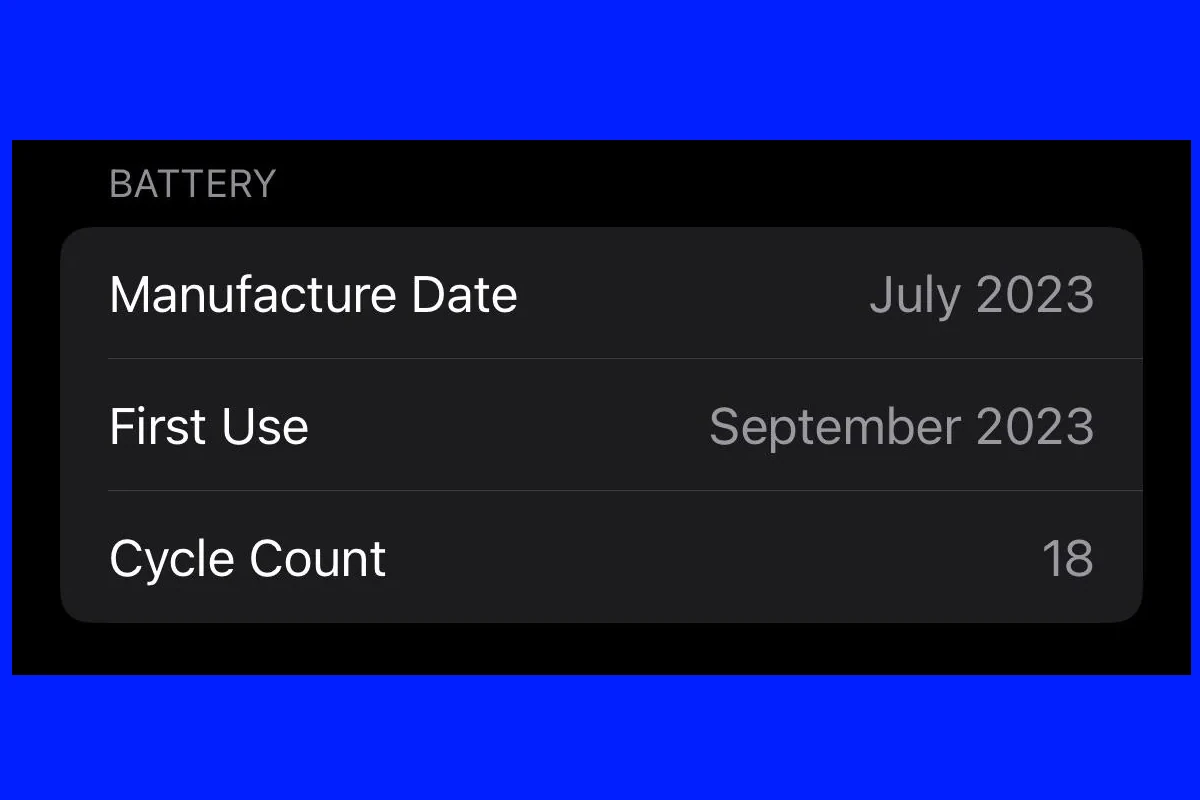Apple has made it easier for iPhone 15 and 15 Pro users to access battery health information in iOS 17. For the first time, you can see your battery cycle count directly in settings. Just go to Settings > General > About. If you have an older phone model, the process becomes MUCH more complicated (but still possible) because you’ll need to interpret the analytics logs. The good news is that you can create a shortcut to help you get the battery cycle count from those logs, however.
Understanding and managing your iPhone’s battery cycle count and health is crucial for ensuring optimal performance and longevity. By following the tips and strategies outlined in this article, you can significantly extend the life of your iPhone’s battery, making the most of your device in various real-world scenarios.
Finding Your Battery Cycle Count in iOS
Apple has made some changes to how users can access their battery cycle count in recent iOS versions.
For iPhone 15 Models:
- Good News: If you have an iPhone 15 model running iOS 17 or later, you can easily find your battery cycle count directly within the Settings app.
- How to Check: Go to Settings > General > About and scroll down to the new “Battery” section. You’ll see the exact cycle count displayed there.
For Older iPhone Models:
- The Challenge: Unfortunately, Apple removed the direct access to battery cycle count from the Settings app in older iPhone models with iOS 16 and later.
- Workarounds:
- Third-Party Apps: Some third-party apps available on the App Store may still be able to access and display your battery cycle count. However, be cautious when downloading and granting permissions to these apps.
- Connect to a Mac: If you have a Mac, you can connect your iPhone and use the “System Information” utility to view the battery cycle count.
- Use a Shortcut: There are shortcuts available online that can potentially retrieve the battery cycle count information from your iPhone’s analytics data. However, this method may not be reliable and could change with future iOS updates.
Remember: Battery cycle count is just one factor in determining overall battery health. The “Battery Health” percentage in Settings provides a more general indication of your battery’s condition. If you’re experiencing significant battery drain or other issues, consider contacting Apple Support or visiting an authorized repair center.
Methods to Check Your Battery Cycle Count
There are three main ways you can find out your iPhone’s battery cycle count:
| Method | Description | Pros | Cons |
|---|---|---|---|
| Using a Shortcut | Install a shortcut (like Battery Stats) on your iPhone to access battery information, including cycle count. | Easy to use, quick access to data. | Requires installing a third-party shortcut. |
| Requesting an Apple Analytics Report | Ask Apple to send you an analytics report, which includes the cycle count. | Official method, provides detailed data. | Can take several days to receive the report. |
| Using Third-Party Apps | Download apps designed to show battery information, including cycle count. | Often offer additional battery health features. | Not all apps are reliable, may collect data. |
Using a Shortcut
The quickest way is to use a shortcut like Battery Stats. Here are some steps you can follow:
Shortcut link: https://www.icloud.com/shortcuts/19fa84ecd2cd48d9bce30ee66bc1f73e
How to use it?
- Add the shortcut
- Go to Settings > Privacy > Analytics & Improvements > Analytics Data
- Then choose the file with the newest date, that says “Analytics-YYYY-MM-DD-######.ips”
- Open the file & share it to the shortcut
If you want a different shortcut, simply search google for “Battery Stats shortcut iOS” online to find and install it. Once installed, it’s as easy as tapping the shortcut to see your cycle count.
Requesting an Apple Analytics Report
This method is a bit more involved but gives you the most accurate information. Go to Settings > Privacy & Security > Analytics & Improvements > Analytics Data. Look for a file called “log-aggregated-[date].ips.” Open it in the Files app and search for “cyclecount.” The number next to it is your total cycle count.
Using Third-Party Apps
Several apps on the App Store can show your battery cycle count and other battery health details. Be sure to choose a reputable app with good reviews. Some popular options include CoconutBattery (for Mac) and iMazing.
Remember, your iPhone’s battery is a consumable component. It’s designed to retain up to 80% of its original capacity at 500 complete charge cycles. Even if your cycle count is high, it doesn’t necessarily mean your battery needs immediate replacement. It’s just a good indicator of its overall health.
Key Takeaways:
- Battery Cycle Count: A vital metric for assessing battery health.
- iOS 17 Update: New methods to access battery health information.
- Tools and Shortcuts: Utilize iOS features for detailed battery insights.
- Maintenance Tips: Best practices for prolonging battery life.
Step-by-Step Video Guide
For a visual walkthrough on finding your battery cycle count in iOS 17, watch this detailed video tutorial below:
How To Check Your Battery Cycle Count
The process for checking your battery cycle count was made very easy by Apple (if you have an iPhone 15 series) as they now display the info right in the Settings > General > About section. It doesn’t get much easier than that. But if you’re still using an older iPhone, however, you’ll need to follow the steps below to find out how to get your count.
Instructions For iPhone 15, 15 Plus, 15 Pro, or 15 Pro Max
Apple has simplified the process for iPhone 15 and 15 Pro series phones. There’s now a section dedicated to viewing your current battery cycle count so you don’t have to do anything additional. Here are the steps:
- Open Settings: On your iPhone 15, start by opening the ‘Settings’ app.
- Go to General: In the Settings menu, scroll down and select ‘General’.
- Go To The About Section: Within General, find and tap on ‘About’.
- Scroll to Battery Information: In the About section, scroll down to the bottom where you will find a subsection labeled ‘Battery’.
- View Cycle Count: In the Battery section, look for ‘Cycle Count’. This number represents the total number of battery cycles your iPhone has gone through.
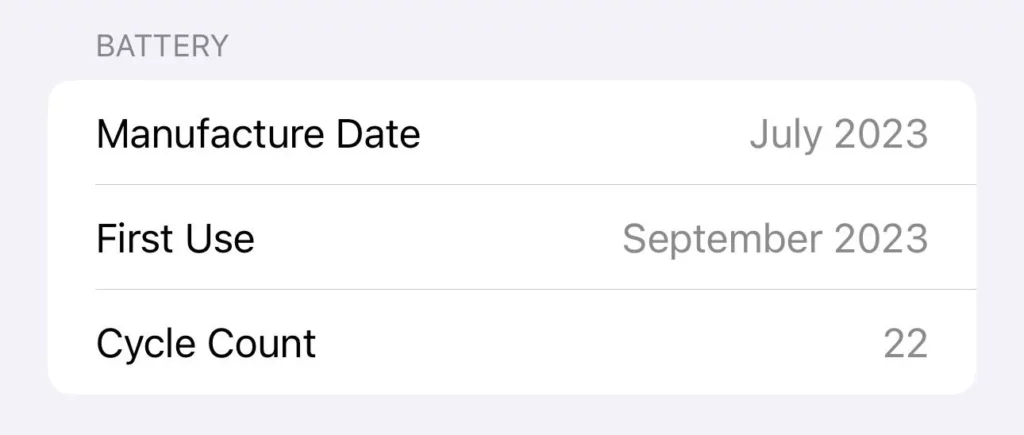
For Older iPhone Models (Running iOS 17 or later)
For older iPhone generations (14, 13, 12, 11, etc.) it’s not quite as easy, but if you follow the steps below exactly you’ll get the information you’re looking for. Remember to download the shortcut link and then go step by step through the procedure:
Download the Shortcut: First, you need to download a specific shortcut to check the battery cycle count. The link to this shortcut can be found here:
https://www.icloud.com/shortcuts/730616b6e59c4f18b5d99aa9fff7a47b
Open Settings: On your iPhone, open the ‘Settings’ app.
Navigate to Privacy and Security: Scroll down in the Settings menu and select ‘Privacy and Security’.

Go to Analytics and Improvement: Within Privacy and Security, find and tap on ‘Analytics and Improvement’.
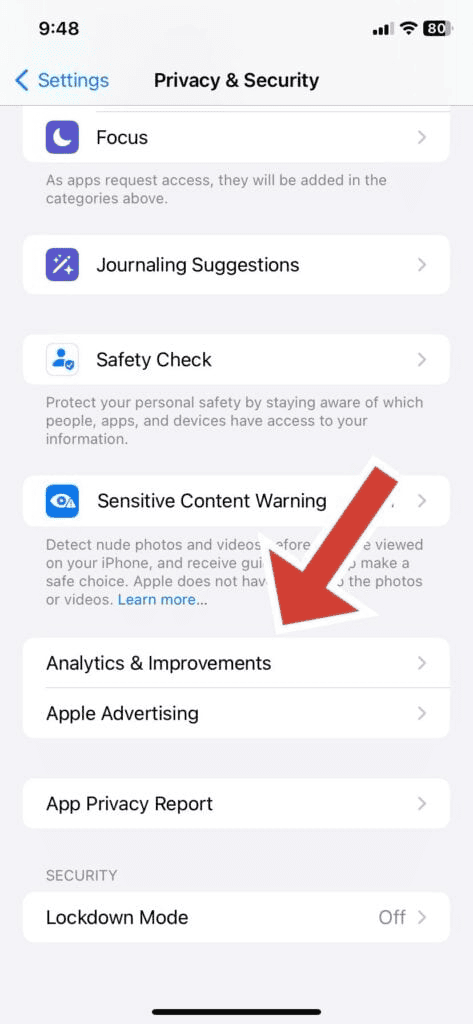
Access Analytics Data: In the Analytics and Improvement section, select ‘Analytics Data’.
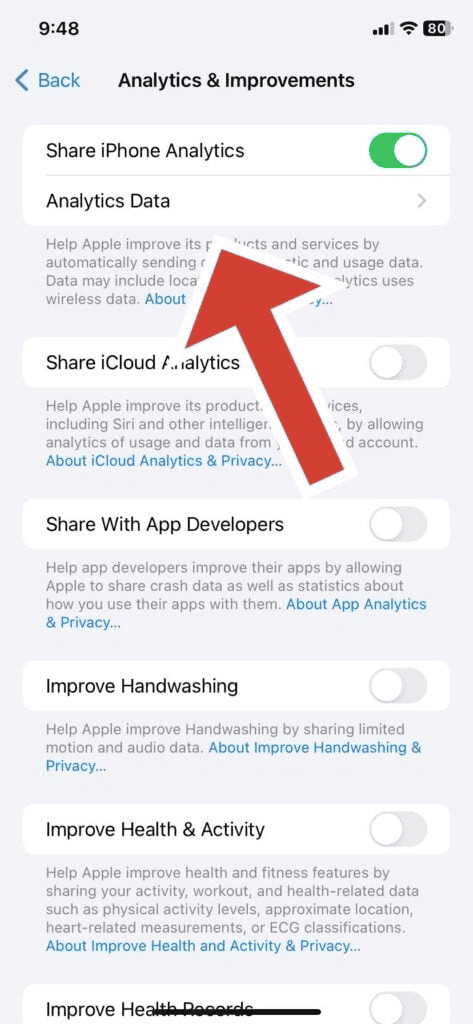
Select the Latest Analytics File: Look for the most recent analytics data file, which is typically named Analytics followed by a hyphen, then the date, then more text (e.g., ‘Analytics-2023-12-14-xxxxxx.xxx’).
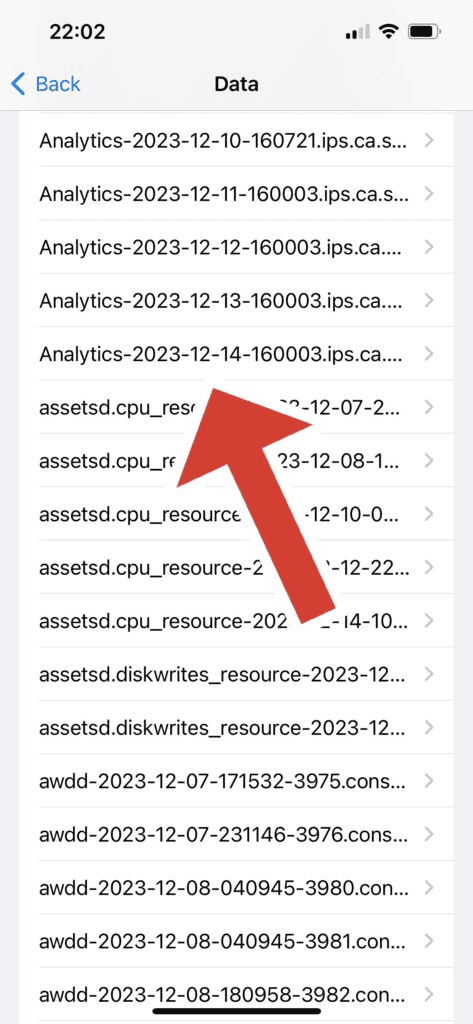
Share the Analytics Data: Tap on the analytics file to open it, then click on the ‘Share’ icon.
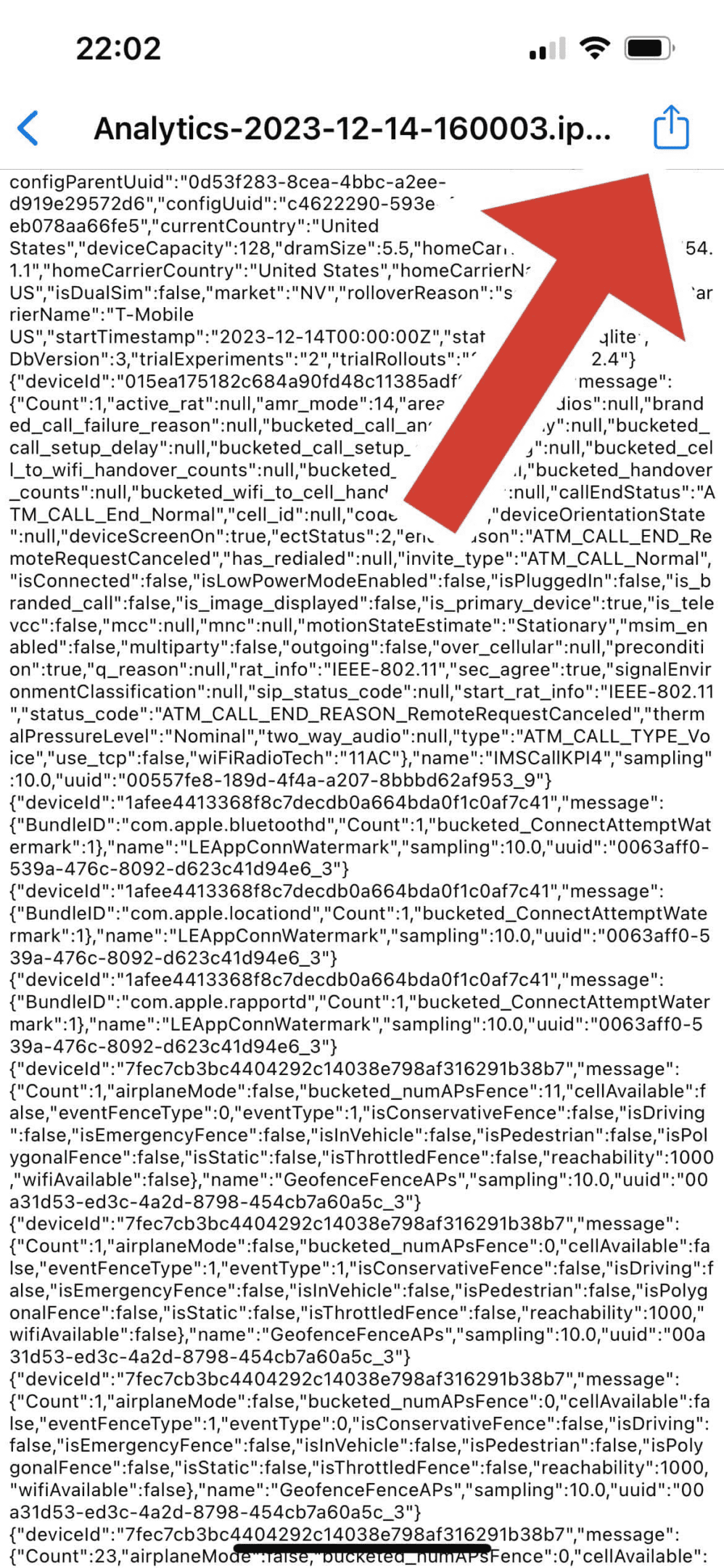

Run the Battery Checker Shortcut: In the share options, select the ‘Battery Checker’ shortcut that you downloaded earlier. This will process the analytics data to extract battery information. You might be asked what your device type is and then the model.
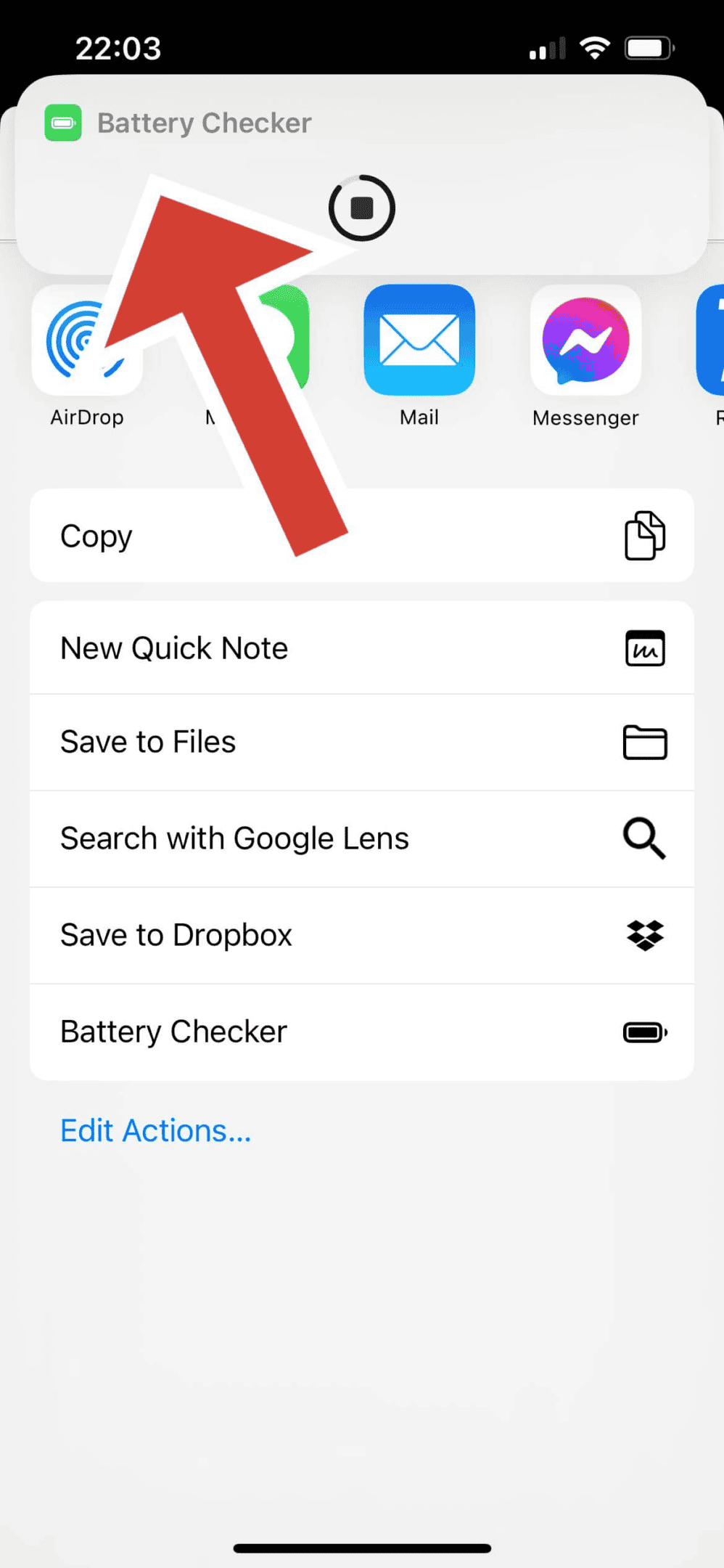
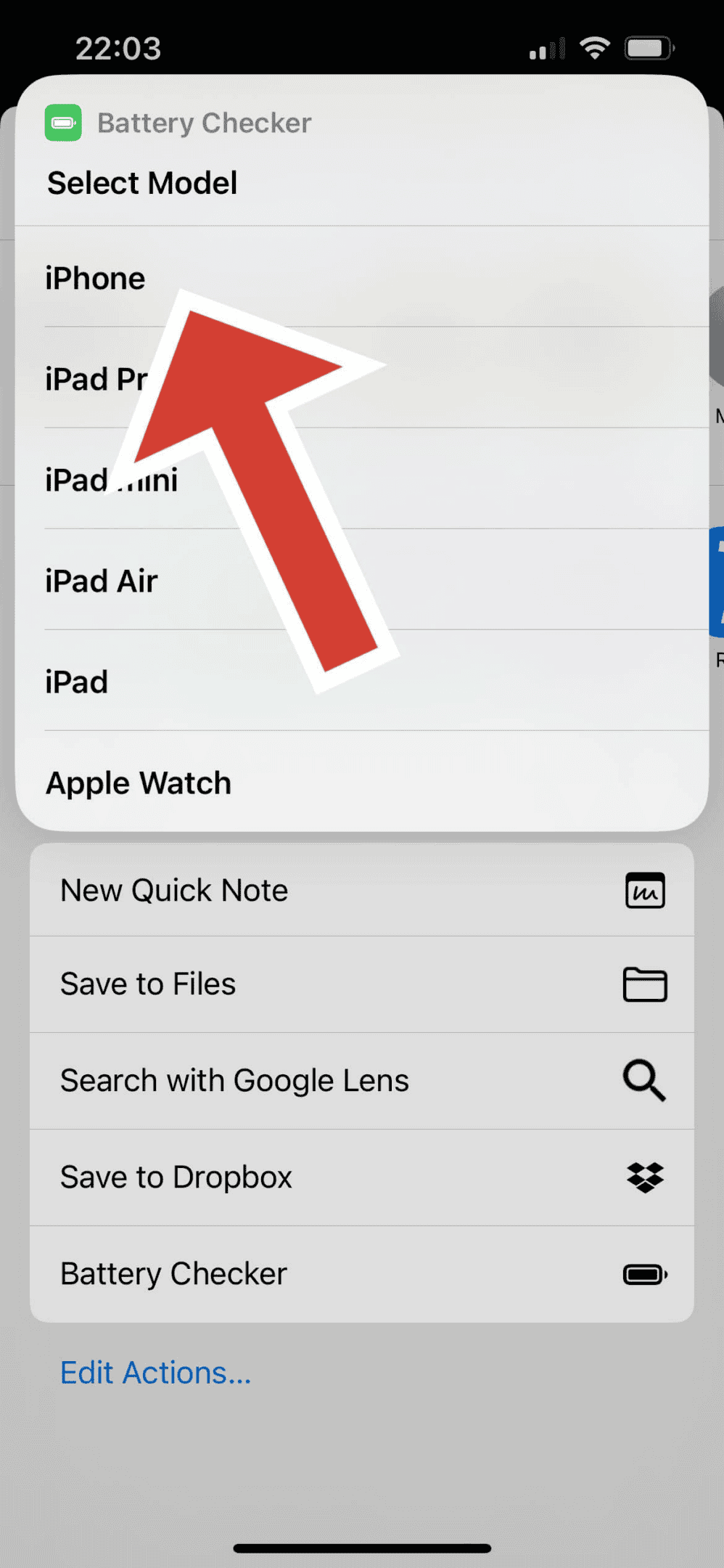
View Cycle Count and Other Information: The shortcut will display the battery cycle count along with other relevant battery information.
Remember, the exact steps might vary slightly depending on the version of iOS and the specific model of your iPhone. Always ensure your device is updated to the latest iOS version to access these features.
Understanding iOS 17 Battery Health Changes
This section looks into the technical aspects of these changes and how they impact your iPhone’s performance.
- Explanation of the new battery health reporting system in iOS 17.
- Comparison with previous iOS versions.
- Impact on iPhone performance and longevity.
iPhone Shortcut For Real Battery Health
If you’re just looking for the Battery Health shortcut link and already know the procedure, you can download it here.
https://www.icloud.com/shortcuts/730616b6e59c4f18b5d99aa9fff7a47b
Understanding Battery Cycle Count
So what exactly is your battery cycle count? Simply put, a battery cycle count is the number of complete charge cycles your iPhone’s battery has undergone. One cycle is counted when you’ve used (and then recharged) 100% of your battery’s capacity, but not necessarily all in one go. For instance, if you use 50% of your battery one day and recharge it fully overnight, then use another 50% the next day, that counts as one full cycle.
Why Battery Cycle Count Matters
- Longevity: The cycle count gives you an idea of how long your battery can last before it needs replacing.
- Performance: As the cycle count increases, the battery’s capacity to hold charge decreases, affecting your device’s performance.
Step-by-Step Guide To Obtain Battery Health
- Accessing Battery Settings: Navigate to the ‘Settings’ app and select ‘Battery.’
- Battery Health: Tap on ‘Battery Health’ to view your battery’s maximum capacity and peak performance capability.
- Additional Tools: For a more detailed view, including the cycle count, you might need to use specific shortcuts or third-party apps designed for iOS 17. See the guide above.
Tools and Shortcuts for Battery Health Monitoring
iOS 17 offers several tools and shortcuts that provide deeper insights into your battery’s health. The shortcut we recommend can be downloaded from this iCloud link.
Utilizing iOS Shortcuts
- Battery Stats Shortcut: This tool gives you a quick overview of your battery’s health, including the cycle count.
- Analytics Shortcut: Delve deeper into your battery usage and health metrics through this shortcut.
Maximizing Battery Health and Cycle Count
Maintaining your iPhone’s battery health is crucial for ensuring its longevity. Here are some tips to keep your battery in top shape:
Tips for Maintaining Battery Health
- Avoid Extreme Temperatures: Keep your iPhone away from extremely hot or cold environments.
- Optimized Battery Charging: Enable this feature in your settings to reduce battery aging.
- Regular Updates: Keep your iOS updated for the latest battery health optimizations.
Troubleshooting Common Battery Issues in iOS 17
Even with careful use, you might encounter battery-related issues. Here’s how to troubleshoot them:
Identifying and Resolving Issues
- Battery Drain: Check for apps that consume excessive battery and update or uninstall them if necessary.
- Battery Health Decline: If your battery’s health is declining rapidly, consider consulting an Apple authorized service provider.
Advanced Insights into iOS 17 Battery Management
iOS 17 not only brings a fresh interface but also introduces enhanced battery health management tools. These tools are designed to give users more control and understanding of their device’s battery health.
Key Features
- Battery Health Reporting: Get detailed reports on your battery’s performance and health.
- Optimized Charging Patterns: iOS 17 learns your charging habits to optimize battery charging, reducing wear.
Real-World Applications and Impact
Understanding your iPhone’s battery cycle count and health has tangible benefits in everyday technology use. Let’s consider a few scenarios:
Scenario 1: The Busy Professional
Imagine you’re a busy professional relying heavily on your iPhone for work. Knowing your battery’s health and cycle count helps you plan for a battery replacement at the right time, ensuring you’re never caught off guard with a dying phone during critical moments.
Scenario 2: The Tech Enthusiast
As a tech enthusiast, keeping tabs on your battery’s health allows you to optimize its performance, ensuring you get the most out of your device’s cutting-edge features without compromise.
This video further explains how to find your exact iPhone battery cycle count in iOS 17 and earlier versions.
Tips for Prolonging Battery Life
To keep your iPhone’s battery in top condition, consider these tips:
Best Practices
- Avoid Full Discharges: Try to charge your iPhone when it drops to around 20-30%.
- Smart Charging Habits: Don’t leave your iPhone plugged in all the time. Unplug it once it reaches 100%.
Troubleshooting Advanced Battery Issues
Sometimes, despite best efforts, you might face complex battery issues. Here’s how to tackle them:
Advanced Troubleshooting Techniques
- Calibrating Battery: Occasionally fully discharge and then recharge your iPhone to calibrate the battery indicator.
- Seek Professional Help: If you notice significant battery health deterioration, it might be time to consult an Apple authorized service provider.
FAQs
Let’s address some more common questions about battery cycle count:
Can iOS updates affect battery health?
Yes, sometimes new iOS updates can temporarily impact battery performance until the system optimizes itself.
Is it harmful to use my iPhone while it’s charging?
Generally, it’s safe, but it’s better to avoid heavy usage during charging to reduce heat build-up.
How accurate is the battery health reported in iOS?
It’s quite accurate, but remember, it’s a software estimation and can have a small margin of error.
How often should I check my battery cycle count?
It’s a good practice to check it every few months to get an idea of your battery’s health and usage patterns.
What is a good battery cycle count?
Generally, a battery is considered healthy if it has a cycle count of less than 500.

